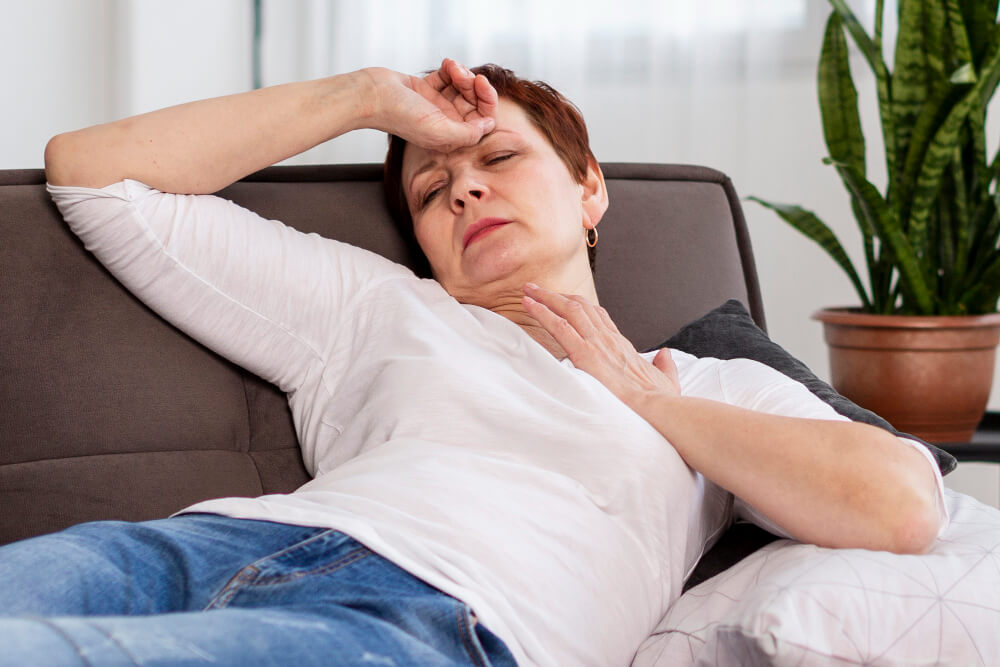We sometimes add products that we believe may be beneficial to our readers. We may receive a small commission if you purchase using the links on this page. Read our affiliate disclaimer
Menopausal symptoms signs mark a significant phase in a woman’s life, signaling the end of her reproductive years. This transition often brings various symptoms that can begin years before menopause, during the perimenopausal stage. Understanding these signs early can help manage them more effectively. Below, we explore 34 common menopausal symptoms signs with detailed descriptions.

1. Hot Flashes
A sudden feeling of intense heat spreads over the body, particularly the face and upper chest. Hot flashes often cause sweating and may be followed by chills. They can happen unexpectedly, interfering with both daily activities and sleep.
2. Night Sweats
Severe hot flashes that occur during sleep, cause excessive sweating that may soak nightclothes and bedding. Night sweats often lead to sleep disturbances and can contribute to fatigue.
3. Irregular Periods
As menopause approaches, menstrual cycles become erratic. Periods may be shorter or longer, lighter or heavier, and the time between periods may vary. This unpredictability can be one of the first signs of menopause.
4. Vaginal Dryness
Reduced estrogen levels result in thinning and drying of the vaginal tissues, which can cause itching, burning, and pain during intercourse, making sexual activity uncomfortable or even painful.
5. Mood Swings
Hormonal fluctuations during menopause can lead to sudden and intense changes in mood. Women may feel irritable, anxious, or depressed without an obvious cause, making emotional regulation more challenging.
6. Fatigue
Constant tiredness that doesn’t go away with rest is a common symptom. This fatigue can be overwhelming, affecting concentration, energy levels, and overall productivity.
7. Sleep Disturbances
Insomnia or difficulty staying asleep is common during menopause. Women may find it hard to fall asleep, wake up frequently during the night, or wake up too early and be unable to get back to sleep.
8. Memory Issues
Cognitive symptoms like forgetfulness, difficulty concentrating, and mental fogginess are frequently reported. These changes can be frustrating and may impact daily functioning and work performance.
9. Weight Gain
Hormonal changes during menopause can lead to weight gain, especially around the abdomen. This type of weight gain is often difficult to manage with diet and exercise alone and can increase the risk of developing conditions such as diabetes and heart disease.
10. Thinning Hair
Many women experience thinning hair on the scalp during menopause, while some notice increased facial hair. This change is often related to hormonal shifts and can be distressing.
11. Dry Skin
Reduced estrogen levels can cause the skin to lose moisture and elasticity, leading to dryness, itching, and an increase in wrinkles and fine lines.
12. Joint Pain
A decline in estrogen can lead to increased inflammation, resulting in joint pain, stiffness, and swelling. This can affect mobility and quality of life, particularly if the pain is chronic.
13. Headaches
Menopause can trigger more frequent and severe headaches, including migraines. These headaches are often linked to hormonal fluctuations, and they can be debilitating.
14. Breast Tenderness
Just as during menstruation, hormonal changes during menopause can cause the breasts to become swollen, tender, and sore.
15. Dizziness
Hormonal changes can cause episodes of dizziness or lightheadedness. This may occur suddenly and can be accompanied by a sensation of spinning or imbalance.
16. Heart Palpitations
A racing or irregular heartbeat can be alarming and is sometimes linked to hormonal fluctuations during menopause. While often harmless, it’s important to seek medical advice if palpitations are frequent or severe.
17. Anxiety
Increased feelings of nervousness and worry are common during menopause. This anxiety can be generalized or related to specific situations, and it can significantly impact mental well-being.
18. Depression
The hormonal changes of menopause can trigger or exacerbate depression, leading to persistent feelings of sadness, hopelessness, and a loss of interest in activities that were once enjoyable.
19. Irritability
Menopause can make women more prone to irritability and anger, often over minor issues. These emotional outbursts can strain relationships and increase stress.
20. Panic Attacks
Sudden, intense episodes of fear are often accompanied by physical symptoms such as a racing heart, sweating, and shortness of breath. Panic attacks can be terrifying and are sometimes mistaken for heart attacks.
21. Decreased Libido
A drop in sexual desire is common during menopause, often due to hormonal changes, vaginal dryness, and emotional factors like stress or body image concerns.
22. Urinary Incontinence
The loss of bladder control, particularly when sneezing, coughing, or laughing, is common during menopause due to weakening pelvic floor muscles.
23. Frequent Urination
An increased need to urinate, often with urgency, can disrupt daily life. This symptom is sometimes linked to bladder changes or infections.
24. Bloating
Hormonal fluctuations can lead to fluid retention and bloating, causing discomfort and a feeling of fullness in the abdomen.
25. Digestive Issues
Menopause can slow digestion, leading to symptoms like constipation, diarrhea, and nausea. These changes can be managed with dietary adjustments and staying hydrated.
26. Burning Mouth Syndrome
A persistent burning sensation in the mouth, lips, or tongue, sometimes accompanied by a metallic taste. The cause is unclear, but it may be related to hormonal changes.
27. Gum Problems
Menopausal women may experience sore, bleeding, or receding gums as a result of reduced estrogen levels. Maintaining good oral hygiene and having regular dental check-ups can help manage these symptoms.
28. Body Odor Changes
Hormonal changes can alter body odor. Increased sweating and changes in the skin’s chemistry can lead to a more pronounced or different smell.
29. Osteoporosis
A decrease in bone density makes bones more fragile and prone to fractures. This risk increases after menopause due to lower estrogen levels.
30. Muscle Loss
The decline in muscle mass and strength is common during menopause, leading to physical weakness and an increased risk of falls
31. Cold Flashes
Similar to hot flashes but characterized by a sudden feeling of cold, often accompanied by shivering. Cold flashes can be just as disruptive as hot flashes.
32. Itchy Skin
The loss of collagen and moisture in the skin during menopause can lead to increased dryness and itchiness, often requiring special skincare routines to manage.
33. Tingling Sensations
Some women experience tingling, prickling, or “pins and needles” in the hands, feet, or other extremities. This sensation may be due to fluctuating hormone levels affecting the nervous system.
34. Eye Issues
Hormonal changes during menopause can lead to dry eyes, sensitivity to light, or blurred vision. Proper eye care and hydration can help alleviate these symptoms.
Conclusion
Understanding the variety of menopausal symptoms signs is crucial for managing this transitional phase effectively. From physical changes like hot flashes and joint pain to emotional challenges such as anxiety and depression, being aware of these symptoms allows for proactive management and better quality of life.
Resources
Image Designed by Freepik
References
Freeman, E. W., et al. (2007). “Symptoms associated with menopausal transition and reproductive hormones in midlife women.” Obstetrics & Gynecology, 110(2), 230-240. DOI: 10.1097/01.AOG.0000270153.59193.67
Greendale, G. A., et al. (2005). “Symptoms of the menopause.” Clinical Obstetrics and Gynecology, 48(4), 856-865. DOI: 10.1097/01.grf.0000188211.35146.59
Avis, N. E., et al. (2003). “The multi-ethnic study of women’s health across the nation (SWAN): Aims, methods, and results from the screening phase.” American Journal of Epidemiology, 157(9), 869-879. DOI: 10.1093/aje/kwg071
Soules, M. R., et al. (2001). “Stages of Reproductive Aging Workshop (STRAW).” Fertility and Sterility, 76(5), 874-878. DOI: 10.1016/s0015-0282(01)02869-0
Nelson, H. D. (2008). “Menopause.” Lancet, 371(9614), 760-770. DOI: 10.1016/S0140-6736(08)60346-3
Gold, E. B. (2011). “The timing of the age at which natural menopause occurs.” Obstetrics & Gynecology Clinics of North America, 38(3), 425-440. DOI: 10.1016/j.ogc.2011.05.002
Santoro, N. (2016). “Perimenopause: From research to practice.” Journal of Women’s Health, 25(4), 332-339. DOI: 10.1089/jwh.2015.5556
Chedraui, P., et al. (2009). “Impact of obesity on estrogen receptor and hot flashes in postmenopausal women.” Maturitas, 63(4), 338-342. DOI: 10.1016/j.maturitas.2009.05.006
Kravitz, H. M., et al. (2003). “Sleep in midlife women: SWAN Sleep Study.” Sleep, 26(6), 740-743. DOI: 10.1093/sleep/26.6.740
Joffe, H., & Cohen, L. S. (1998). “Estrogen, serotonin, and mood disturbance: Where is the therapeutic bridge?” Biological Psychiatry, 44(9), 798-811. DOI: 10.1016/s0006-3223(98)00166-0



